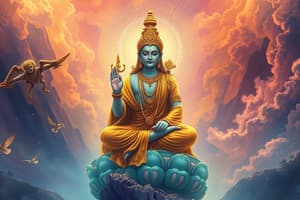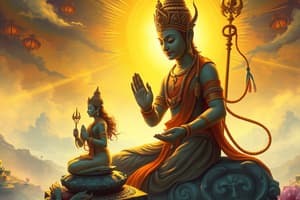Podcast
Questions and Answers
What is the name of the supreme God in Hindu belief?
What is the name of the supreme God in Hindu belief?
- Allah
- Vishnu
- Brahman (correct)
- Brahma
In the Christian creation story, what is described as being formless and dark at the beginning?
In the Christian creation story, what is described as being formless and dark at the beginning?
- The Waters
- The Earth (correct)
- The Heavens
- The Angels
Which model of the solar system was proposed by Nicolaus Copernicus?
Which model of the solar system was proposed by Nicolaus Copernicus?
- World Turtle Model
- Geocentric Model
- Earth-centered Model
- Heliocentric Model (correct)
How many major planets revolve around the Sun in our solar system?
How many major planets revolve around the Sun in our solar system?
What does the term 'solar' refer to in the context of the solar system?
What does the term 'solar' refer to in the context of the solar system?
Which of the following claims describes the geocentric model?
Which of the following claims describes the geocentric model?
What role do angels play in the Islamic creation story?
What role do angels play in the Islamic creation story?
Which cultural mythology includes the World Turtle as part of its creation narrative?
Which cultural mythology includes the World Turtle as part of its creation narrative?
What evidence did Edwin Hubble provide to support the Big Bang theory?
What evidence did Edwin Hubble provide to support the Big Bang theory?
Which element is NOT typically associated with the abundance of light elements predicted by the Big Bang theory?
Which element is NOT typically associated with the abundance of light elements predicted by the Big Bang theory?
What does the Steady State theory imply about the creation of matter in the universe?
What does the Steady State theory imply about the creation of matter in the universe?
Which concept describes the initial rapid expansion of the universe proposed by Inflation theory?
Which concept describes the initial rapid expansion of the universe proposed by Inflation theory?
Which mineral property describes its overall shape or growth pattern?
Which mineral property describes its overall shape or growth pattern?
Which of the following describes a mineral with a flattened and thin crystal structure?
Which of the following describes a mineral with a flattened and thin crystal structure?
Which of the following is a physical property of minerals?
Which of the following is a physical property of minerals?
Which mineral is commonly associated with electric wiring?
Which mineral is commonly associated with electric wiring?
Which mineral is known to always be strongly magnetic?
Which mineral is known to always be strongly magnetic?
What characteristic do striations in minerals exhibit?
What characteristic do striations in minerals exhibit?
How is specific gravity defined?
How is specific gravity defined?
Which mineral reacts visibly with dilute hydrochloric acid?
Which mineral reacts visibly with dilute hydrochloric acid?
Which of the following minerals is toxic?
Which of the following minerals is toxic?
Which class of minerals includes silver as an example?
Which class of minerals includes silver as an example?
What criterion classifies minerals under the Dana System?
What criterion classifies minerals under the Dana System?
What distinctive quality do some minerals have concerning their feel?
What distinctive quality do some minerals have concerning their feel?
Which of the following classes does feldspar belong to?
Which of the following classes does feldspar belong to?
What is the primary characteristic of minerals classified as oxides?
What is the primary characteristic of minerals classified as oxides?
What is a common effect of exposure of metallic sulfide minerals to air and water?
What is a common effect of exposure of metallic sulfide minerals to air and water?
Which class of minerals includes gypsum?
Which class of minerals includes gypsum?
Which class of minerals does not include a significant amount of silicon?
Which class of minerals does not include a significant amount of silicon?
Which class of minerals is defined by having carbonate as part of their chemical composition?
Which class of minerals is defined by having carbonate as part of their chemical composition?
Which mineral class is primarily composed of phosphate compounds?
Which mineral class is primarily composed of phosphate compounds?
Mineraloids differ from other classes of minerals primarily because they:
Mineraloids differ from other classes of minerals primarily because they:
What key mathematical contributions did Copernicus make regarding planetary positions?
What key mathematical contributions did Copernicus make regarding planetary positions?
Which spectral type characterizes the Sun as a star?
Which spectral type characterizes the Sun as a star?
How long does it take for sunlight to reach the Earth?
How long does it take for sunlight to reach the Earth?
What astronomical term describes planets from the Greek meaning 'wanderer'?
What astronomical term describes planets from the Greek meaning 'wanderer'?
Why is Venus known as Earth's twin?
Why is Venus known as Earth's twin?
What is unique about a day on Venus compared to a year?
What is unique about a day on Venus compared to a year?
Which characteristic is NOT true about Mercury?
Which characteristic is NOT true about Mercury?
Who were the proponents of the Big Bang theory in 1920?
Who were the proponents of the Big Bang theory in 1920?
Flashcards are hidden until you start studying
Study Notes
Religious Accounts of Creation
- Hinduism: Belief in Brahman, a supreme God. Creation involves Lord Vishnu from whose navel a lotus flower emerges with Brahma, who divides it into Heaven, Earth, and Sky.
- Islam: Allah is eternal and created the universe by command. He created living creatures, angels, planets, and rain for vegetation.
- Christianity: Creation starts with "In the beginning, God created the heavens and the earth." The Earth was initially formless and dark, leading to a seven-day creation account.
The Solar System
- Composed of celestial bodies bound by gravitational forces; dominated by the Sun.
- The solar system consists of 8 major planets, over 170 satellites, and 4 dwarf planets.
- The term "solar" originates from "sol," Latin for Sun.
Models of the Solar System
- World Turtle: Mythical giant turtle supporting the Earth; found in various cultures, including Hindu and indigenous American mythologies.
- Geocentric Model: Early theory placing the Earth at the universe's center, proposed by Claudius Ptolemy.
- Heliocentric Model: Developed by Nicolaus Copernicus, suggesting the Sun as the center; provided mathematical proofs for planetary positions.
The Sun
- Classified as a yellow dwarf star (G2V), despite its light appearing white.
Earth-Sun Distance
- Earth is approximately 151.87 million km from the Sun, located in the "Goldilocks zone." Sunlight reaches Earth in about 8.5 minutes.
The First Four Planets
- Mercury: Closest to the Sun, fastest orbiting and smallest planet, with gravity at 38% that of Earth’s.
- Venus: Brightest planet and Earth's twin, known as the evening star. Unique characteristics include a longer day than year, clockwise rotation, and being hotter than Mercury.
- Earth: Known as the Blue Planet, the only planet with known life; name derived from Old English and German terms for ground.
The Universe's Creation
- Big Bang Theory: Proposed by Alexander Friedman and Georges Lemaître; universe formed around 13.7 billion years ago from a compact point.
- Supporting Evidence:
- Galaxies moving away (Edwin Hubble's discoveries).
- Cosmic Microwave Background radiation (discovered by Arno Penzias and Robert Wilson).
- Light element abundance aligning with Big Bang predictions.
Alternative Theories
- Steady State Theory: Proposed by Bondi, Gold, and Hoyle; suggests universe maintains density while expanding.
- Inflation Theory: Introduced by Alan Guth and others; proposes rapid expansion of the universe before traditional Big Bang expansion.
Minerals
- Found in everyday life; examples include hematite, chromite, copper, quartz, gold, feldspar, and fluoride.
Physical Properties of Minerals
- Crystal Habit: Shape of crystals categorized as equant, elongate, or platy.
- Luster: Reflective quality of minerals; can be metallic, glassy, or dull.
- Magnetism: Ability of minerals to attract to magnets; exemplified by magnetite.
- Specific Gravity: Ratio of a mineral's weight to an equal volume of water; varies among minerals.
- Taste, Odor, Feel: Some minerals exhibit distinctive tastes, smells, and textures (e.g., halite tastes like salt).
Chemical Properties of Minerals
- Characteristics: Reactivity with acids, presence of toxic substances, and potential radioactivity in certain minerals.
- Classification: Minerals categorized by chemical composition into native elements, silicates, oxides, sulfides, sulfates, halides, carbonates, phosphates, and mineraloids.
Studying That Suits You
Use AI to generate personalized quizzes and flashcards to suit your learning preferences.




